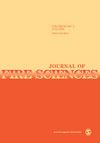锥形量热计试验中可燃物接收的入射热流演变的实验测定:火焰辐照度的影响
IF 1.9
4区 工程技术
Q2 ENGINEERING, MULTIDISCIPLINARY
引用次数: 5
摘要
锥形量热计中聚合物材料的分解动力学在很大程度上取决于施加在样品表面的辐照度水平。事实上,即使假设在锥形量热计测试期间辐照度水平保持恒定,火焰发出的热通量也会大大增加材料接收的总热通量。用可控气氛锥形量热计对最近获得的丙烯腈-丁二烯-苯乙烯质量损失率结果进行分析处理表明,在通风良好的环境和惰性环境之间观察到的差异可归因于火焰的影响。这一观察结果使得有必要确定燃烧过程对材料热分解的影响。为此,在锥形量热计测试过程中,基于在丙烯腈-丁二烯-苯乙烯材料基体中插入热通量计,设计了一系列实验,以测量作为分解和燃烧过程函数的火焰热通量。本文章由计算机程序翻译,如有差异,请以英文原文为准。
Experimental determination of the evolution of the incident heat flux received by a combustible during a cone calorimeter test: Influence of the flame irradiance
The decomposition kinetic of polymeric materials in a cone calorimeter strongly depends on the irradiance level imposed at the sample’s surface. Indeed, even if the irradiance level is supposed to be kept constant during cone calorimeter test, the amount of heat flux which is emitted by the flame can greatly increase the total heat flux received by the material. Analytical treatment on recently obtained results of an acrylonitrile-butadiene-styrene’s mass loss rate with controlled atmosphere cone calorimeter has shown that the differences observed between well-ventilated and inert environments can be attributed to the impact of the flame. This observation has brought the necessity to determine the impact of the flaming process on the material thermal decomposition. To do so, series of experiments have been devised, based on the insertion of a heat fluxmeter within the matrix of an acrylonitrile butadiene styrene material, during cone calorimeter tests in order to measure the flame heat flux as a function of the decomposition and the combustion processes.
求助全文
通过发布文献求助,成功后即可免费获取论文全文。
去求助
来源期刊

Journal of Fire Sciences
工程技术-材料科学:综合
CiteScore
4.00
自引率
0.00%
发文量
14
审稿时长
2.5 months
期刊介绍:
The Journal of Fire Sciences is a leading journal for the reporting of significant fundamental and applied research that brings understanding of fire chemistry and fire physics to fire safety. Its content is aimed toward the prevention and mitigation of the adverse effects of fires involving combustible materials, as well as development of new tools to better address fire safety needs. The Journal of Fire Sciences covers experimental or theoretical studies of fire initiation and growth, flame retardant chemistry, fire physics relative to material behavior, fire containment, fire threat to people and the environment and fire safety engineering. This journal is a member of the Committee on Publication Ethics (COPE).
 求助内容:
求助内容: 应助结果提醒方式:
应助结果提醒方式:


